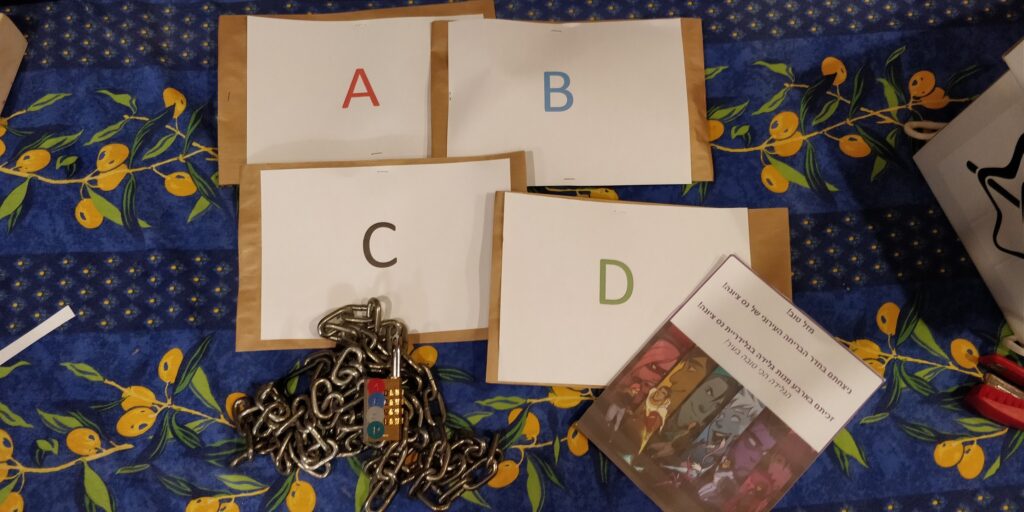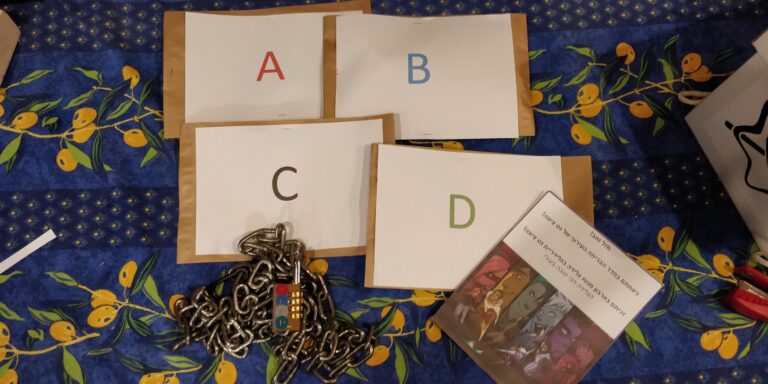A while back I was running a “Masks – a New Generation” campaign. If you’re not familiar with it, it’s a cool, powered by the apocalypse, roleplaying game by Magpie Games in which you play a teen with superpowers but without control or the maturity of life experience. It takes place in a modern setting and the teens you are playing are living in a similar scape to the world we’re living in (minus the superpowers).
Some of the main themes of the game are confronting failures, handling guilt and being different. Somethings that I’m sure all of us can relate to.
I had four players in my group and a few sessions ago we had a very emotional session. The party failed to collaborate in order to protect innocent civilians from harm and all the characters felt guilty and ashamed. So one of the players had her character suggest that they all go to an escape room for a team-building group activity to cheer up the rest of the party.
My GM mind immediately sparked an idea. At the end of the gaming session, I sat down and planned how to create an escape room experience for my players. Yes, for my players, not just their characters.
Creating the Escape room

As I often do when planning my gaming sessions I started at the end and worked my way backward. After the escape room scene, I wanted the session to continue so I made the prize an in-game group voucher for the town local ice cream parlor. I created a simple voucher, printed it and placed it inside a real locked box with some chocolates as a reward. In order to get the box and lock I had to improvise but luckily I’m a professional improviser. I took an old bike chain and locked it with a four digits combination lock.
Now I had the basis. I decided to use the combination lock and create four riddles, the answer to each one of the riddles will be a single-digit number and all together will form the code to open the locked box. In order to get the sequence right, I marked the riddles with letters A, B, C, and D and also market each letter on the combination lock. Just to be sure, I also color-coded all the riddles and the marking on the lock.
Next, the riddles.
I don’t care much for riddles and puzzles in my games because I find it blur the line between what the character can do and what the player can do. But here it was essential. It was indeed, the whole point. I also color coded the riddles so it will be easier to match them to the right digits on the lock. Here are the riddles I used, feel feel to use them or create your own:
Letters Cypher (red) – I took a quote from a song that was written about the city in which our campaign takes place (it’s a real city in an alternative world) and replace some of the letters with other symbols. I also included a list assigning each letter a numerical number (In Hebrew it’s called Gematria). The players needed to find out what letter each symbol represents and use the letters to solve a simple mathematical equation.

Navigation Riddle (blue) – I printed out a map of the city we’re playing in and added a short description of the route of someone going from their home to the ice cream parlor. Based on the description of the route (“I walk on the main street, turn left at the first intersection…” etc). Following the convoluted instructions the party had to locate the ice cream parlor on the map, and the map coordinates contained the answer. Meaning the ice cream parlor was in (D,5) and the answer was 5. To create an extra challenge, I printed the map in an extra small size and provided a magnifying glass. Because the magnifying glass detective vibe is awesome. One of the reasons for this riddles was to establish the existence of the ice cream parlor as a famous location in the city so that the prize at the end would feel natural.
On what year was… (Black) – This was a simple one. I wrote down a list of questions in the style of “In what year was the Philippines named and by whom?” it was 1543, and the reason for this question was that one of the player characters is from the Philippines. another question was “In what year was the first commercial arcade machine created?”, Yes, you guessed it, one of the characters is an arcade character that emerged into the real world (and it’s the Computer Space game by Atari in 1971). The players had to perform a simple summation of all the years and then add the digits until they got a number. The point here was to give every player a piece of information related to their character. The players look up some of the answers on their phone which was awesome because that would be what their characters would have done.
Mirrored Writing (green) – I copied a long paragraph from Wikipedia about numbers and in the middle of it add the sentence “the answer to the escape room question is 4”. Then I flipped the text to its mirror image. I thought that the players would try to read it as is and when they will despair run to a mirror. But it turned out they simply used their phones to flip the image back. Good for them.
To get the finished look I placed every riddle in a brown envelope and place a large colored letter in it and hid it around the room. I avoided the whole “one answer lead to another” because my apartment wasn’t that big and I wanted them to focus on the game as a group, not run around.
Extra Help
Tips – I’ve added a simple tip at the bottom of each riddle so that the players could decide if they wanted some help. One of the reasons I did this is that some of the players could choose to sneak a pick and not tell the other players. Why? Well, remember that they are playing teenagers and all have fragile egos. So I wanted to give my players some chances to misbehave within the boundaries of the game.
Asking for clues – In an escape room, you can usually ask the operator for a clue if you have a problem. I created some clues in case the players will ask for them. For example I created a larger version of the map and some more clearly phrased instructions. At the end, there was no need for these but the fact that I as the room operator could ask the players if they need a clue was a good way to instill a sense of urgency in the players.
Running the escape room
When the players arrived I asked them to wait in the next room and quickly set up the room. Placing the box in plain sight on the living room table with one of the riddle envelopes next to it in order for them to get the idea and follow up.
I then got into the character of the room operator and went to my players. Calling them by their character names immediately clued them in that we are in play and telling them that “the escape room they booked is ready and that they should follow me inside” set the scene.
After they entered the room I said that they can call me if they need any clues and left, trusting my players to carry the idea forward. I was not disappointed. Listening from beyond the door I heard mutterings of “this is stupid, why do we need to do this?”, “Is this a game? It feels like a game?” and “OK, team, let’s get to it!”. All very distinctly the words of the characters I’ve been running this game to. I was overjoyed.
Later I entered the room, both inplay, and offplay, guiding the scene as a GM should. My acting and LARPing experience helping me to know when to intervene and when to hold back and let the players do their thing.
Continuing the session

After the players finished their tasks, opened the prize box, and celebrated their victory I invited everyone to sit down, signaling that the LARP section of the session was over. But not quite, I took out two large boxes of ice cream and placed them on the table. Explaining that the session continues when the characters are enjoying their ice cream reward at the local ice cream parlor. This eased our way back to continue the gaming session.
Summary
Having an escape room was a great experience both for me and for my players. I got to plan a whole new kind of experience and my players got to play their characters in a whole new way. In episode 75 of On the Shoulders of Dwarves we’ve talked about special sessions and how much they can help a campaign. I think one of the most important things to remember about your game is that a GM should always be alerted to new possibilities. Whether these possibilities are a new direction for your plot, a chance to add an important NPC or a chance to fashion a new experience for your players.




